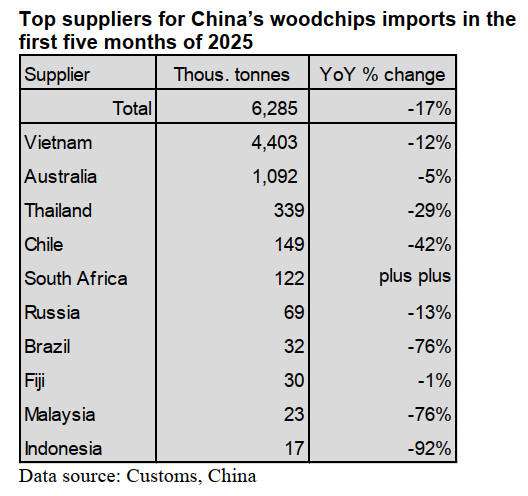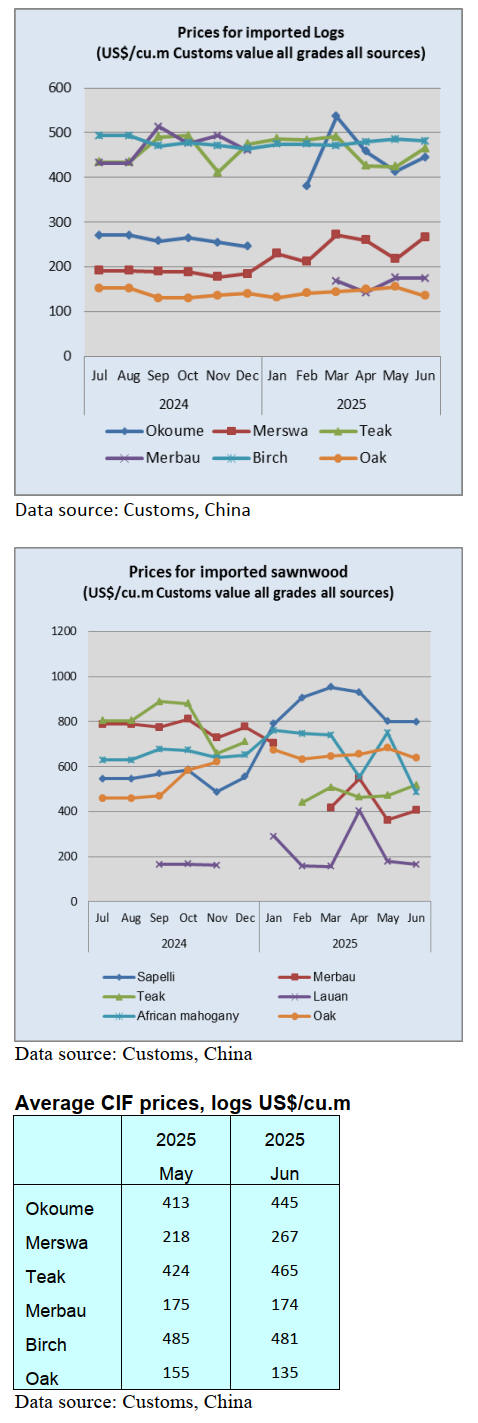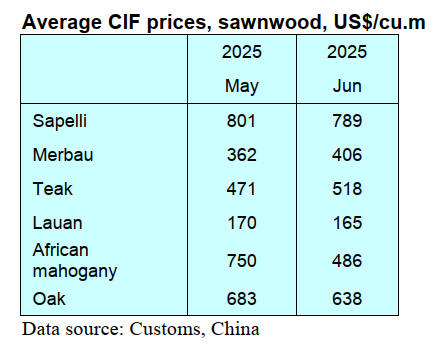US Dollar Exchange Rates of
25th
July
2025
China Yuan 7.17
Report from China
OSB consumption Guideline
An Oriented Strand Board (OSB) Consumption Guideline
has been released. This Guideline helps consumers
understand OSB through simple language and pictures.
The Guideline elaborates on OSB characteristics and
applications, key qualities and environmental protection
indicators. Also presented are inventories of major
manufacturing enterprises in terms of product
classification, quality identification, environmental
protection indicators and purchase information.
The release of the Guideline is of significance for
regulatingthe OSB market and guiding consumers to
consume rationally. It provides consumers with a scientific
and practical basis for selection which helps enhance their
self-protection and prevents them from being misled. At
the same time it also promotes the orderly development of
the OSB industry and creates a favorable market
environment.
It is believed that the OSB industry will embrace new
development opportunities. It is expected that consumers
will pay more attention to this type of board, enhance
market awareness and acceptance and thereby fully
unleash the value and application potential of OSB.
See:
https://ishare.ifeng.com/c/s/v002507vnqfpcG9ShdNR9NGbSFeQ
Gnm--X-_r-_ofNx4l3JyT4__
Wooden furniture via China-Europe freight trains
Buying globally and selling globally, in Nankang District,
Ganzhou City, Jiangxi Province, relying on the China-
Europe freight trains, a furniture industry with an output
value of over RMB280 billion is booming.
The Ganzhou International Land Port Station accepts
China-Europe freight trains with European spruce and fir.
Nankang was neither along the border nor by the sea. In
the past it took three months to transport timber from
Russia at a cost as high as RMB4,000 per cubic metre.
Today, relying on the China-Europe freight trains, the
transport time has been shortened to 14 days and the
overall logistics cost has been reduced by 18%.
Relying on the "port + bonded + cross-border" linkage
model of Ganzhou International Land Port, Nankang
furniture has appeared in international markets.
It has been exported to countries in Europe, America,
Southeast Asia, Central Asia and the Middle East with
overseas orders signed exceeding RMB5 billion in 2024.
Nankang has successfully established a complete
industrial supply chain integrating wood trading, design
and research and development, intelligent manufacturing
and logistics distribution. There are over 10,000 furniture
enterprises and more than 500,000 employees in Nankang.
In 2024 the Ganzhou International Land Port has operated
over 1,600 China-Europe (Asia) freight trains covering
more than 100 cities in five Central Asian countries and
over 20 European countries.
Wood-based panel industry in first half 2025
According to the Industrial Development Planning
Institute of the National Forestry and Grassland
Administration, China's plywood industry has declined in
terms of number of enterprises but there has been an
increase in total production capacity.
The fibreboard industry shows a trend of a decline in the
number of enterprises and a continued contraction in total
production capacity.
The particleboard industry has witnessed a slight decline
in the number of enterprises and a slowdown in the growth
of total production capacity in the first half of 2025.
By the end of June 2025, there were around 5,200
plywood product manufacturing enterprises in China
distributed across 26 provinces (municipalities and
autonomous regions), a decrease of approximately 800
enterprises compared to the end of 2024. The total
production capacity is approximately 248 million cubic
metres per year, representing a 12% increase compared to
the end of 2024.
In the first half of 2025 three fibreboard production lines
(including one continuous flat press line) was completed
and put into operation adding a production capacity of
520,000 cubic metres per year.
By the end of June 2025 228 fibreboard manufacturing
enterprises in China had 252 fibreboard production lines
and the factories were distributed across 21 provinces
(municipalities and autonomous regions) with a total
annual production capacity of 40.64 million cubic metres.
The net reduction in fibereboard production capacity was
1.19 million cubic metres representing a further decrease
of around 3% compared to the end of 2024.
Of the factories, there were 122 continuous flat pressure
lines with a combined production capacity of 27.42
million cubic metres per year.
The fibreboard industry showed a further downward trend
in the number of enterprises, production lines and total
production capacity. There are five fibreboard production
lines under construction across the country with a
combined annual production capacity of 1.18 million
cubic metres.
In the first half of 2025 9 particleboard production lines
(including 7 continuous flat pressing lines) were put into
operation adding production capacity of 3.27 million cubic
metres per year.
At the end of June this year 298 particleboard
manufacturing enterprises across the country had 323
particleboard production lines distributed in 22 provinces
(municipalities and autonomous regions)with a total
production capacity of 66.76 million cubic metres per
year, a net annual increase of 2.61 million cubic metres.
Among them, there were 149 continuous flat pressure lines
with a combined production capacity of 49.51 million
cubic metres per year and the proportion of total panel
production capacity rose to 74% over the same period of
2024. The particleboard industry shows a trend of a slight
decline in the number of enterprises and production lines
as well as a slowdown in the growth of total production
capacity.
There are 23 particleboard production lines under
construction across the country with a combined
production capacity of 7.05 million cubic metres per year.
The risk of overheated investment in the particleboard
industry still exists.
Strict Standard on formaldehyde emission limits
The State Administration for Market Regulation recently
issued a new national standard for wood-based panels, GB
18580-2025, "Formaldehyde Emission Limits for Indoor
Decoration and Renovation Materials – Wood-based Panel
and its Products". This comes into effect on 1 June 2026
and replaces GB 18580-2017.
The new Standard incorporates E0 and E1 grade standards
into regulatory requirements and further refines the
classification and testing methods for wood-based panel.
The formaldehyde limit indicators have become more
strict.
The new national Standard clearly defines wood-based
panels and products thereof for the first time. In addition
to classification, the new national Standard has also
changed the formaldehyde emission limit to a grading
requirement, uniformly using E0 and E1 grades as the
judgment criteria.
At the same time the testing methods were standardised
and a "small lab method" was added in the production
quality control process making the detection and
management more scientific and rigorous.
Surge in woodchips imports from South Africa
According to China Customs woodchips imports totalled
6.285 million tonnes in the first five months of 2025,
down 17% over the same period of 2024.
Vietnam and Australia are the largest and the second
largest suppliers of China’s woodchips imports,
accounting for 87% of the national total. However,
China’s woodchips imports from Vietnam and Australia
fell 12% and 5% respectively in the first five months of
2025.
China’s woodchips imports from the other top suppliers
except South Africa dropped at a fast pace in the first five
months of 2025. China’s woodchips imports from South
Africa surged in the first five months of 2025.

June Global Timber Indices for China
China Customs data shows that in May 2025 total wood
imports reached 4.966 million cubic metres, a 17%
decrease compared to the same period in 2024.
Specifically, log imports stood at 2.961 million cubic
metres, down 18.5% year-on-year, while sawnwood
imports reached 2.005 million cubic metres, down 15%.
It is worth noting that imports of African wood to China
continued to shrink in the first five months of 2025. The
total import volume was 813,700 cubic metres, a 31% year
on year decrease.
On 11 June, China announced that it would implement a
policy of granting 53 African countries having diplomatic
relations with China zero-tariff treatment for all tariff
lines, expanding the scope from 33 countries, with newly
added countries such as Gabon, the Republic of the
Congo, Ghana, Cameroon and Angola.
Wood products would also enjoy zero-tariff treatment
which is expected to boost the export of wood from
African countries to the Chinese market.
Recently, China's plywood industry faced significant
export challenges. On 12 June, the US Department of
Commerce announced the initiation of antidumping duty
and countervailing duty investigations on hardwood and
decorative plywood from China, Indonesia and Vietnam.T
he preliminary antidumping duty rate for Chinese products
was set at 504.07%, far exceeding the rates of 138.04% -
152.41% for Vietnamese products and 84.94% for
Indonesian products.
On 10 June the European Commission officially
announced a preliminary affirmative determination in the
antidumping duty investigation of hardwood plywood
from China. Except for an enterprise subject to a 25.1%
provisional antidumping duty, other Chinese companies
face a rate of 62.4%.
In June 2025 the GTI-China index registered 57.5%, a
decrease of 0.1 percentage point from the previous month
and has been above the critical value (50%) for 4
consecutive months indicating that the business prosperity
of the timber enterprises represented by the GTI-China
index expanded from the previous month. In June, China's
timber sector still saw an upward trend on both production
and consumption; however, the expansion was not so
obvious.
As for the sub-indexes, all the twelve indexes were above
the critical value of 50%. Compared to the previous month
the index for inventory of finished products increased by
0.2 percentage point while the indexes for production, new
orders, export orders, existing orders, purchase quantity,
purchase price, import, inventory of main raw materials,
employees, delivery time and market expectation declined
by 0.2-1.7 percentage point(s).
See: https://www.itto-
ggsc.org/static/upload/file/20250716/1752653872183995.pdf


|